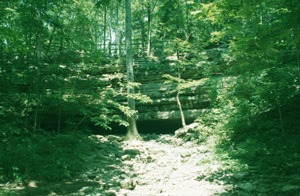
Cedars of Lebanon State Park
During the Great Depression, the federal government worked to adapt the nation's marginal farmlands to better use. To that end, Congress first appropriated $20 million for reclamation and later approved another $50 million. The State of Tennessee applied for a share of the funds for use to reclaim areas where submarginal soil had been stripped of every profitable source of income.
Early in December 1934 county extension agent Louis Sawyer and forest service representatives surveyed a portion of southern Wilson County for inclusion in the reclamation plan. The original cedar forest in this area supported a substantial industry that used the red cedar wood for many purposes, especially in the manufacture of pencils. After the forest was logged out, area families tried to make a living from the shallow rocky soils and submarginal lands. Later that same month State Forester James O. Hazard approved the area for a reforestation project.
The Wilson Cedar Forest Project, later renamed the Lebanon Cedar Forest Project, intended to develop a cedar forest through reforestation techniques on the glady land, place the forest development under government control, and provide employment for citizens in the economically depressed area. In September 1935 President Franklin Roosevelt approved the Lebanon Cedar Forest Project.
Two months later the Resettlement Administration of the U.S. Department of Agriculture began development in what is now Cedars of Lebanon State Park, which was among the first state parks in Tennessee. The Works Project Administration (WPA) hired workers from among the farmers whose land made up the project to build roads, install power lines, complete boundary surveys, and construct buildings, cabins, and shelters from the red cedar wood and abundant limestone rock. The best example of the WPA's work is the Cedar Forest Lodge, which initially served as the park office, recreation hall, and superintendent's residence. It is listed on the National Register of Historic Places. A lookout tower and nursery were also built on the site. Over 750,000 seedlings were grown and replanted to restore the once large cedar forest.
On September 10, 1937, Lebanon Cedar Forest formally opened. Dixon Merritt, editor of the Lebanon Democrat, who had been instrumental in gaining approval for the project, presided over the dedication and laying of the cornerstone. The Tennessee Department of Conservation took over the management of the area in March 1939, with the U.S. Forestry Service as custodial agency. The project area was renamed Cedars of Lebanon after the dense cedar woodland that existed in the biblical lands of Lebanon. The Cedars of Lebanon State Park and Forest operated as a reclaimed forestry area and a recreation facility, complete with swimming pool, lodge, cabins, picnic tables, shelters, and athletic fields for public enjoyment.
During the years of World War II the park area operated mainly for the purpose of providing recreational activities to the soldiers of the Second Army who were on maneuvers in Middle Tennessee. From 1942 through 1944 military personnel accounted for 90 percent of park attendance.
The federal government formally deeded Cedars of Lebanon State Park to the state on August 12, 1955. Since then, the Division of State Parks and the Division of Forestry have shared its management. Cedars of Lebanon has continued to expand its recreational facilities and now contains 117 modern campsites, a group lodge that will sleep eighty people, an Olympic-size swimming pool, eleven picnic shelters, a nature center, a recreation hall, nine modern cabins, and eight miles of hiking trails. Rangers provide security and information for visitors. A park naturalist is available to interpret the natural, cultural, and historic aspects of the park. As the twenty-first century approaches, Cedars of Lebanon continues to provide a place for visitors to enjoy the outdoors and reflect back on the dedication and work of those who built one of Tennessee's early state parks.



